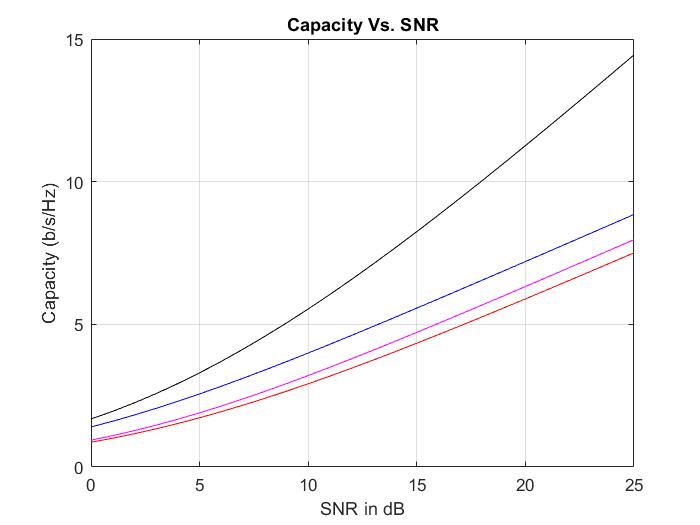



Introduction
Multiple Input Multiple Output(MIMO) using Matlab.
Multiple Input Multiple Output (MIMO) is a technology used in wireless communication systems to increase the data rate, reliability, and coverage of wireless communications. In MIMO, multiple antennas are used at both the transmitting and receiving ends to simultaneously transmit and receive multiple signals.
The basic idea behind MIMO is to exploit the multipath environment of wireless communications, where signals from a single transmitter reach the receiver via multiple paths. By transmitting multiple signals from multiple antennas at the same frequency and time, MIMO can increase the data rate of the wireless communication system. This is because the additional signals provide independent channels for data transmission, and the receiver can combine the signals from the multiple antennas to improve the quality of the received signal.
MIMO also improves the reliability of wireless communications by reducing the impact of fading, which is a phenomenon that occurs when signals from different paths arrive at the receiver with different strengths. By using multiple antennas at the receiver, MIMO can reduce the impact of fading, because the fading on one antenna path may not affect the signal received by another antenna.
In addition, MIMO can improve the coverage of wireless communications by increasing the spatial reuse of the available frequency spectrum. This is because MIMO enables multiple signals to be transmitted and received simultaneously, without interfering with each other, even if they are using the same frequency.
MIMO is a key technology used in modern wireless communication systems, such as Wi-Fi, LTE, and 5G, and it is an important enabler for high-speed, high-capacity wireless communication systems.
Software Requirement
Matlab Software or
The components of a MIMO system
- Multiple Antennas: Both the transmitter and receiver have multiple antennas that are used to transmit and receive multiple signals. The number of antennas can vary depending on the system requirements, but typical configurations include 2×2, 4×4, and 8×8 MIMO systems.
- Channel Coding: Channel coding is used to encode the data transmitted over the MIMO system. The channel coding algorithms can include forward error correction (FEC) codes, such as convolutional codes, turbo codes, and low-density parity-check (LDPC) codes, to improve the reliability of the transmitted data.
- Modulation: Modulation is used to map the data bits onto the carrier signals transmitted by the antennas. The modulation techniques used in MIMO systems can include orthogonal frequency division multiplexing (OFDM), single-carrier frequency division multiple access (SC-FDMA), and others.
- Multiplexing: Multiplexing is used to transmit multiple data streams over the MIMO system. The multiplexing techniques used in MIMO systems can include spatial multiplexing, where different data streams are transmitted by different antennas, and spatial division multiplexing (SDM), where different data streams are transmitted over different subspaces of the MIMO system.
- Signal Processing: Signal processing is used at both the transmitter and receiver to perform tasks such as channel estimation, equalization, and data detection. These algorithms can be implemented using analog or digital circuits, or a combination of both.
- Load: The load represents the devices that use the MIMO system to communicate, such as mobile phones, laptops, and wireless routers.
- Optional Feedback Circuit: In some MIMO systems, a feedback circuit can be used to send information from the receiver to the transmitter about the channel conditions, such as the channel gain and phase, and the quality of the received signals. This information can be used by the transmitter to adjust the transmission parameters, such as the modulation scheme, coding rate, and power level, in order to improve the quality of the communication link.
Matlab Code
clc;
close all;
clear all;
mT = 2; % No.of transmitters
mR = 2; % No.of receivers
ITER = 1000; % number of iterations.
SNRdB = [0:25]; % SNR maximum scale
SNR = 10.^(SNRdB/10); % SNR in decibels
C_SISO = zeros(1,length(SNR));
C_SIMO = zeros(1,length(SNR));
C_MISO = zeros(1,length(SNR));
C_MIMO = zeros(1,length(SNR));
for ite = 1:ITER
h_SISO = (randn +1i*randn)/sqrt(2);
h_SIMO = (randn(mR,1)+1i*randn(mR,1))/sqrt(2);
h_MISO = (randn(1,mT)+1i*randn(1,mT))/sqrt(2);
h_MIMO = (randn(mR,mT)+1i*randn(mR,mT))/sqrt(2);
for K = 1:length(SNR)
C_SISO(K) = C_SISO(K) + log2(1+ SNR(K)*norm(h_SISO)^2);
C_SIMO(K) = C_SIMO(K) + log2(1+ SNR(K)*norm(h_SIMO)^2);
C_MISO(K) = C_MISO(K) + log2(1+ SNR(K)*norm(h_MISO)^2/mT);
C_MIMO(K) = C_MIMO(K) + log2(abs(det(eye(mR)+SNR(K)*h_MIMO*h_MIMO'/mT)));
end
end
C_SISO = C_SISO/ITER;
C_SIMO = C_SIMO/ITER;
C_MISO = C_MISO/ITER;
C_MIMO = C_MIMO/ITER;
plot(SNRdB,C_SISO,'r',SNRdB,C_SIMO,'b',SNRdB,C_MISO,'m',SNRdB,C_MIMO,'k')
%legend('SISO','SIMO','MISO','MIMO')
xlabel('SNR in dB')
ylabel('Capacity (b/s/Hz)')
title('Capacity Vs. SNR')
grid;
MIMO Code Output


Explore More Projects on Matlab
- Microwave and Antenna Various Matlab CodesMicrowave and Antenna Various Matlab Codes. Some of the Projects are below. Polar form for a Symmetrical Dipole of Finite… Read more: Microwave and Antenna Various Matlab Codes
- Multiple Input Multiple Output(MIMO) using MatlabIntroduction Multiple Input Multiple Output(MIMO) using Matlab. Multiple Input Multiple Output (MIMO) is a technology used in wireless communication systems… Read more: Multiple Input Multiple Output(MIMO) using Matlab
- Pulse Width Modulation(PWM) working Principal using MatlabIntroduction Pulse Width Modulation(PWM) working Principal using Matlab. PWM stands for Pulse Width Modulation. It is a type of digital… Read more: Pulse Width Modulation(PWM) working Principal using Matlab
- Quadrature Amplitude Modulation(QAM): Theory and MatlabIntroduction Quadrature Amplitude Modulation(QAM): Theory and Matlab QAM stands for Quadrature Amplitude Modulation. It is a method of combining two… Read more: Quadrature Amplitude Modulation(QAM): Theory and Matlab
- Polar form for a Symmetrical Dipole of Finite Length: Matlab ScriptPolar form for a Symmetrical Dipole of Finite Length: Matlab Script. This Experiment include finding of: Introduction The polar form… Read more: Polar form for a Symmetrical Dipole of Finite Length: Matlab Script
- Radiated Power and Maximum Directivity of any Antenna: Theory and Matlab codeRadiated Power and Maximum Directivity of any Antenna: Theory and Matlab code. Introduction The radiated power of an antenna refers… Read more: Radiated Power and Maximum Directivity of any Antenna: Theory and Matlab code
- Polar form for a Loop Antenna with Uniform Current: Theory and Matlab codeIntroduction The polar form for a loop antenna with uniform current can be determined using the far-field approximation and the… Read more: Polar form for a Loop Antenna with Uniform Current: Theory and Matlab code
- Two Dimensional(2-D) Polar and Semi-Polar Patters using Matlab codeIntroduction Two Dimensional(2-D) Polar and Semi-Polar Patters using Matlab code. Two-dimensional (2-D) polar and semi-polar patterns are graphical representations of… Read more: Two Dimensional(2-D) Polar and Semi-Polar Patters using Matlab code
Join us for Regular Updates
| Telegram | Join Now |
| Join Now | |
| Join Now | |
| Join Now | |
| Join Now | |
| Join our Telegram | connectkreations |
About Connect Kreations
We the team Connect Kreations have started a Blog page which is eminently beneficial to all the students those who are seeking jobs and are eager to develop themselves in a related area. As the world is quick on uptake, our website also focuses on latest trends in recent technologies and project learning and solutions. We are continuously putting our efforts to provide you with accurate, best quality, and genuine information. Here we also have complete set of details on how to prepare aptitude, interview and more of such placement/ off campus placement preparation.
Connect Kreations is excited to announce the expansion of our services into the realm of content creation! We are now offering a wide range of creative writing services, including poetry, articles, and stories.
Whether you need a heartfelt poem for a special occasion, a thought-provoking article for your blog or website, or an engaging story to captivate your audience, our team of talented writers is here to help. We have a passion for language and a commitment to creating high-quality content that is both original and engaging.
Our services are perfect for individuals, businesses, and organizations looking to add a touch of creativity and personality to their content. We are confident that our unique perspectives and diverse backgrounds will bring a fresh and exciting voice to your project.
Thank you for choosing Connect Kreations for your content creation needs. We look forward to working with you and helping you to bring your vision to life!
The website is open to all and we want all of you to make the best use of this opportunity and get benefit from it..🤓
- Our Websites: Connect Kreations





